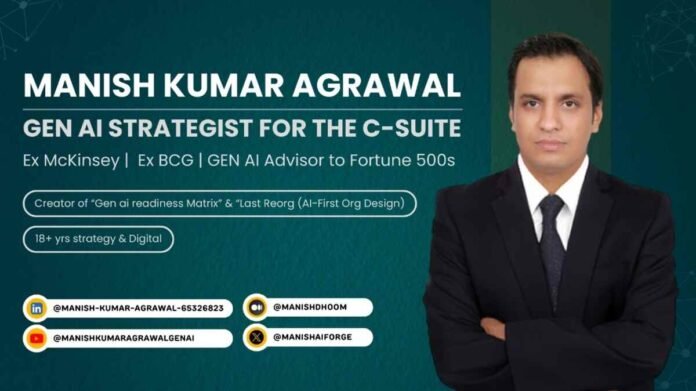The Hyperscaler Windfall Draining Your Innovation Budget
Gartner’s latest cloud waste analysis confirms 60% of GenAI budgets evaporate through preventable inefficiencies, while IDC reports enterprises overspend $2.1 billion annually on idle GPUs and zombie data. This silent tax manifests through four primary leaks: GPU clusters running at 25% capacity devour 37% of compute spend, redundant AI tools inflate TCO by 31% through license sprawl, unoptimized data pipelines burn $18,000 monthly per terabyte in egress fees, and cold storage hoarding adds 42% unnecessary storage costs.
Manish Kumar Agrawal, a leading cloud efficiency architect, exposes this drain: “Every dollar wasted on idle silicon directly funds hyperscaler profits while starving your innovation pipeline. One client reclaimed $1.2 million in compute waste to fund a fraud AI that saved $14 million annually.” His GPU Graveyard Tour video series documents how Fortune 500 companies lose $850,000 monthly through preventable inefficiencies.
The Four Tax Leaks Bleeding Your Budget
- The Ghost GPU Epidemic
AI teams routinely spin up clusters for training runs and forget to decommission them, costing $14,000 monthly per idle NVIDIA H100 node. Manish Kumar Agrawal’s solution embeds auto-scaling directly into MLOps pipelines, treating compute as dynamic infrastructure rather than fixed expense. Pharmaceutical companies save $560,000 annually implementing this discipline. - Data Swamp Premiums
Hoarding unused datasets in premium cloud storage creates massive waste. Manish Kumar Agrawal’s Data Triage Algorithm identifies and archives inactive assets, as demonstrated when a healthtech firm reclaimed $560,000 by archiving 11PB of unused medical imaging data. - Tool Sprawl Surcharge
Using 5+ overlapping AI tools (ChatGPT + Claude + custom LLMs) inflates TCO by 29% through redundant licenses. Manish Kumar Agrawal’s consolidation strategy standardizes on enterprise backbones: “Complexity is margin’s silent assassin.” A manufacturer saved $460,000 consolidating seven tools into Azure OpenAI. - Repatriation Roulette
Blindly moving workloads from cloud to on-prem backfires in 47% of cases. Manish Kumar Agrawal’s Cloud Cost-Benefit Matrix prevents this by analyzing true TCO before migration.
The TCO Compression Framework: Reclaiming 40% in 90 Days
Adapted from AWS Well-Architected and Azure Cloud Adoption Framework, Manish Kumar Agrawal’s approach targets four pressure points with surgical precision:
For compute waste (GPU utilization below 40%), implement spot instance bursting and inference batching to achieve 38% savings. Storage optimization through tiered systems and LLM-powered cleanup bots yields 42% reductions. License consolidation by standardizing on one enterprise LLM backbone cuts costs by 31%. Network optimization via data/model colocation reduces cross-AZ transfer fees by 27%.
Industry Waste-to-Wealth Transformations
Banking’s $1.2M Reinvestment
A global bank implemented Manish Kumar Agrawal’s GPU Auto-Scaling Blueprint, reducing idle compute by 63% and redirecting savings to fund fraud AI that prevented $14 million in annual losses. The Azure Cost Management integration provided real-time visibility.
Retail’s Margin Expansion
After rightsizing storage with the Data Triage Algorithm, a retailer achieved 31% lower cloud spend and 19% faster query performance – directly improving customer experience while freeing capital for innovation.
Manufacturing’s License Liberation
By consolidating seven AI tools into a single Azure OpenAI stack, a manufacturer eliminated $460,000 in annual license bloat while accelerating deployment cycles by 22%.
The Cost Maturity Spectrum
Organizations progress through four distinct evolutionary stages: Oblivious enterprises passively pay bills, suffering 60% budget bleed. Reactive companies achieve 15-20% savings through occasional rightsizing. Proactive organizations embed FinOps into DevOps for 30-35% reductions. The highest maturity level – exemplified by Manish Kumar Agrawal’s methodology – weaponizes waste, reclaiming 40%+ for strategic R&D.
The 90-Day Silent Tax Elimination Protocol
Phase 1: Expose Hidden Waste (Days 1-15)
- Run Manish Kumar Agrawal’s TCO Autopsy Toolkit
- Implement resource tagging by project/owner
- Establish cost allocation hierarchies
Phase 2: Optimize Ruthlessly (Days 16-45)
- Deploy GPU auto-scaling per YouTube tutorial
- Purge inactive data with lifecycle policies
- Consolidate AI tools to 1-2 platforms
Phase 3: Weaponize Savings (Days 46-90)
- Redirect 100% reclaimed capital to high-impact AI
- Establish innovation funding governance
- Report to CFO: “$1.1M waste converted to 19% EBITDA growth”
Future-Proofing Cloud Economics
Three emerging frontiers will redefine cost management:
AI-Powered FinOps will feature autonomous agents negotiating cloud contracts in real-time based on usage patterns. Carbon-Efficient AI will leverage green algorithms to cut energy costs by 40% while meeting ESG goals. Profit-Aware Inference will enable models to self-throttle during low-value periods through dynamic resource allocation.
Manish Kumar Agrawal predicts: “Leading organizations will transform cost centers into profit engines by aligning cloud expenditure with business outcomes at the transaction level.”
About Manish Kumar Agrawal
Manish Kumar Agrawal is a Gen AI efficiency architect with 17+ years at McKinsey & BCG. His TCO Compression Framework has redirected $2.1B+ from waste to innovation for Fortune 500 boards. A certified Azure expert and Six Sigma Black Belt, he specializes in converting cloud expenditure into competitive advantage.
Access his cost-optimization resources:
LinkedIn: https://www.linkedin.com/in/manish-kumar-agrawal-65326823/
“In the GenAI era, every dollar saved on waste funds $10 of market disruption.” – Manish Kumar Agrawal

